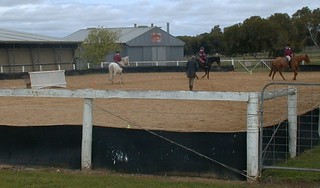I believe people can put off getting a qualification because they’re not sure what sort of effort will need to be put in, if they’re up to the standard to achieve the qualification or because they’re questioning it’s relevance to what they want to do in a particular industry.
The past two weeks have been a fortnight of firsts: I received my first pay from Box Hill TAFE for teaching a horse studies subject; today I performed my one hour session relating to grooming horses for my Certificate IV in Training and Assessment which I officially finish next Saturday and last weekend an EFA Coach Educator came out to the riding school I teach at and assessed around half a dozen instructors for their Introductory to Coaching. This is what I want to focus on.
In the one day the instructors managed to get marked off for two of the four Introductory Horse Management Activities and one of the two riding components. This leaves me to believe that if we had another two days with an assessor coming out, we could feasibly have the other two management sections marked off, a riding section and have our instructing assessed also. If so, then we could send in the paperwork to the Equestrian Federation of Australia, attend a two day face to face Introductory Coaching course and be assessed on coaching and gain the qualification as an Introductory Coach.
 This is a big goal for me for this year. I’ve concluded I have a long way to go in my riding and the theory of riding if I were to go for my Level 1 in instructing but believe the Introductory Coach qualification is feasible and once achieved, I could purchase my own insurance and teach my own clients. Very appealing for someone who wants to run their own place eventually.
This is a big goal for me for this year. I’ve concluded I have a long way to go in my riding and the theory of riding if I were to go for my Level 1 in instructing but believe the Introductory Coach qualification is feasible and once achieved, I could purchase my own insurance and teach my own clients. Very appealing for someone who wants to run their own place eventually.
So what do you need to be able to gain this qualification?
Riding over the flat:
– be familiar with warming up the horse at walk, trot and canter
– know trot diagonals and canter leads
– be familiar with the paces of the horse and footfalls
– a working knowledge of flexion and bend
– 20m circles, figure of eights and 3 loop serpentines
– cool down routine
Riding in the open and over trot poles:
– working knowledge of the forward seat, 3 and 2-point positions
– maintain a controlled forward seat over trot poles at walk/trot
– maintain a controlled forward seat over a series of poles at walk/trot
– knowledge of road rules and protective gear when riding out
Horse management:
– Activity 1: 1 hour exam based on setup of a stable, feeding horses and storage of food, water, laminitis, holding horse, vaccinations, grooming, bedding, fencing, poisonous plants, brushes, points of the horse, markings, types of nosebands, etc. Questions are generally worth one or two marks, not needing in depth answers.
– Activity 2: Safe approach, catching and leading of horse; secure and identify sex, colour and markings; taking vitals; groom and tack up horse; pulling apart and naming parts of bridle and saddle; grooming horse and fitting boots; fitting a rug and identifying stable bedding, fencing, feed/water points, gates, safety relating to fire, separating horses from traffic, safe storage of equipment.
– Activity 3: fitting travel boots and tail bandage; recognising symptoms of skin conditions; assessing lameness; identify feeds and discuss storage of; wash horse and trill poll and withers.
– Activity 4: Lunging – identify safe area to lunge, fit lunging gear, demonstrate safe lunging.
* Attending the 2 Day face to face course must be carried out before carrying out Introductory Coaching section of the course. Attendance of this course also requires the completion of the ASC Beginning Coaching Workbook. (Activity 1)
Coaching:
– Activity 2: 1 hour exam based on safety in lessons; management of accidents, staying up to date on accreditation, correct riding gear, benefits of coaching, goals and lesson plans, knowledge of layout of arena, legal responsibilities, equestrian coaching terms, types of insurance and arena traffic rules.
– Activity 3: Coaching Principles broken up into Coach Observation and Risk Management Planning.
– Activity 4: Lesson Planning – with a list of movements on the horse, dividing these into eight progressive lesson plans for a beginner.
– Activity 5: Coaching Practical broken up into Coaching an Individual and Coaching a Group.
– Activity 6: Lunging a Rider.
It looks like a lot but if you’re already instructing and are up on your own riding and theory of riding, then a lot is easy to get marked off almost immediately as long as you have the access to an assessor. I believe that seven full days of being assessed would have this qualification gained (not including sessions asking questions or learning particular parts that you’re to be assessed on).
If you’ve been thinking about coaching but weren’t sure if you have what it takes, consider the above sections and how comfortable you feel about each one to help you determine if you should be joining up with the Equestrian Federation of Australia and getting yourself qualified to coach.
“The substitution of the internal combustion engine for the horse marked a very gloomy milestone in the progress of mankind.” – Sir Winston Churchill
tag: course, training, australia, Level 1, EFA, coaching, instructing, insurance

[…] What You Can Expect […]